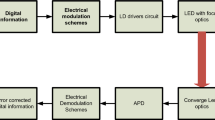Abstract
Free space optical (FSO) communication is one of the most recently developed modes of wireless communication. FSO is a technique used to convey data carried by a laser beam through the atmosphere. While FSO offers a broadband service, it requires a line of sight communication between the transmitter and receiver. The atmosphere has effects on the laser beam passing through it. For instance, the quality of data received is affected by the scattering and atmospheric turbulence. The atmospheric turbulence is caused by both temporary and special random fluctuations of the refractive index along the optical propagation path. Clear air turbulence impairs the performance of the FSO due to the fluctuation in the intensity of the laser beam. By referring to the two criteria, namely bit error rate (BER) and signal to noise ratio (SNR), this work includes analysis of the effect of atmospheric turbulence on FSO systems in Yemen by using an appropriate model.
Similar content being viewed by others
References
Belmonte A, Rodriguez A, Dios F, Cameron A. Phase compensation considerations on coherent, free-space laser communications system. Proceedings of SPIE, 2007, 6736: 6736–6744
Motlagh A C, Ahmadi V, Ghassemlooy Z, Abedi K. The effect of atmospheric turbulence on the performance of the free space optical communications. In: Proceedings of the 6th International Symposium on Communication Systems, Networks and Digital Signal Processing. 2008, 540–543
Li J, Uysal M. Achievable information rate for outdoor free space optical communication with intensity modulation and direct detection. In: Proceedings of Global Telecommunications Conference. 2003, 5: 2654–2658
Zhu X M, Kahn J M. Free-space optical communication through atmospheric turbulence channels. IEEE Transactions on Communications, 2002, 50(8): 1293–1300
Chaman-Motlagh A, Ahmadi V, Ghassemlooy Z. A modified model of the atmospheric effects on the performance of FSO links employing single and multiple receivers. Journal of Modern Optics, 2010, 57(1): 37–42
Prokes A. Modeling of atmospheric turbulence effect on terrestrial FSO link. Radio Engineering, 2009, 18(1): 42–47
Wilkins G D. The diffraction limited aperture of the atmosphere and its effects on free space laser communications. In: Proceedings of the IEEE National Aerospace and Electronics Conference. 1992, 3: 1158–1163
Ishimaru A. Wave Propagation and Scattering in Random Media. New York: IEEE Press, 1978
Andrews L C, Phillips R L. Laser Beam Propagation Through Random Media. Washington: SPIE Optical Engineering Press, 1998
Anguita J, Djordjevic I, Neifeld M, Vasic B. Shannon capacities and error-correction codes for optical atmospheric turbulent channels. Journal of Optical Networking, 2005, 4(9): 586–601
Hemmati H. Near-Earth Laser Communications. California: Taylor & Francis Group, 2008
Fried D L. Limiting resolution looking down through the atmosphere. Journal of the Optical Society of America, 1966, 56(10): 1380–1384
Valley G C. Isoplanatic degradation of tilt correction and short-term imaging systems. Applied Optics, 1980, 19(4): 574–577
Tyson R K. Introduction to Adaptive Optics. Bellingham: SPIE Press, 2000
Willebrand H, Ghuman B S. Free-Space Optics: Enabling Optical Connectivity in Today’s Networks. Indianapolis: Sams Publishing, 2002
Kellaway B, Richardson M A. Laser analysis-part 3. Journal of Battlefield Technology, 2005, 8(1): 30
Xu G L, Zhang X P, Wei J W, Fu X Y. Influence of atmospheric turbulence on FSO link performance. Proceedings of SPIE, 2004, 5281: 816–823
Andrews L C, Phillips R L, Hopen C Y. Laser Beam Scintillation with Applications. Washington: SPIE Optical Engineering Press, 2001
Yuksel H. Studies of the effects of atmospheric turbulence on free space optical communications. Dissertation for the Doctoral Degree. College Park: University of Maryland, 2005, 76–78
Author information
Authors and Affiliations
Corresponding author
Rights and permissions
About this article
Cite this article
Altowij, K.S., Alkholidi, A. & Hamam, H. Effect of clear atmospheric turbulence on quality of free space optical communications in Yemen. Front. Optoelectron. China 3, 423–428 (2010). https://doi.org/10.1007/s12200-010-0123-8
Received:
Accepted:
Published:
Issue Date:
DOI: https://doi.org/10.1007/s12200-010-0123-8




